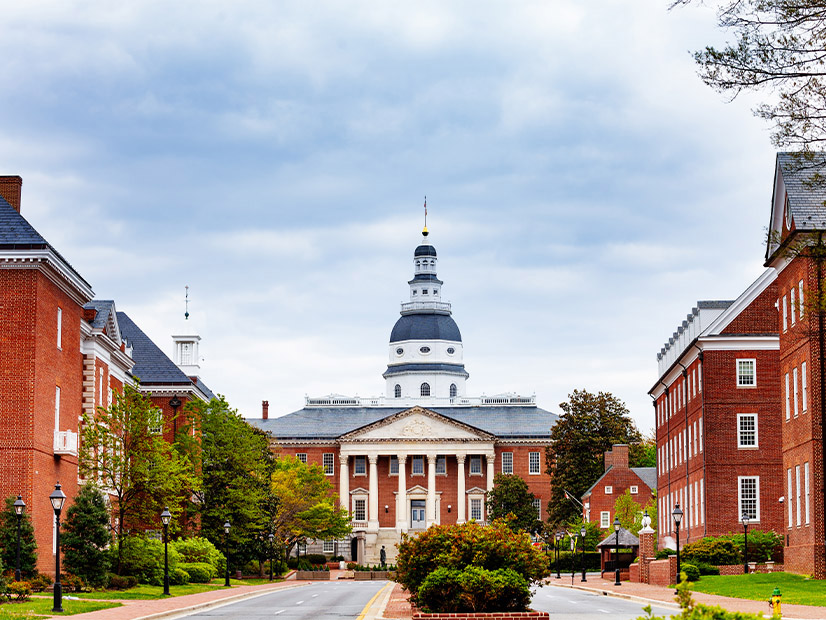
Maryland Gov. Wes Moore (D) wants state-owned buildings to up their energy conservation from the 10% goal set by former Gov. Larry Hogan (R) in 2019 to 20% over a 2018 baseline by 2031.
Moore set the new target in an executive order Thursday, calling on state agencies to green up new buildings and major renovations to ensure that they “align with the state’s goal to achieve net-zero greenhouse gas emissions by 2045.”
The order sets out three strategies for reaching the new conservation target:
- updating the state’s High-Performance Green Building guidelines;
- identifying buildings that could be “potential candidates for energy savings performance contracts”; and
- conducting an annual audit of a certain portion of state buildings to zero in on facilities with the highest energy use per square foot and recommend low-cost measures for increasing their energy efficiency.
“This administration is taking unprecedented action to address climate change, and our state agencies will lead the way,” Moore said in a press release announcing the order. “Achieving more ambitious greenhouse gas emissions-reduction goals is a means to promote the health and wellness of Marylanders not only for tomorrow, but for generations to come.”
According to Nick Cavey, public information officer for the Department of General Services (DGS), the order will apply to Maryland’s 8,000 state-owned buildings, which have a total floor space of 90 million square feet. A state dashboard tracking energy use and costs shows that in the past 12 months, the actual power consumption of those facilities has remained flat, but their electricity bills have gone up 23%, to just under $170 billion.
“These facilities include small, state park campground structures to large government office complexes in Annapolis and Baltimore,” Cavey wrote in an email to NetZero Insider. “They range in age from the Old Treasury Building on State Circle [in Annapolis], which was built in 1736, to facilities currently under construction.”
Moore’s executive order parallels GHG-reduction goals for buildings set in the Climate Solutions Now Act of 2022 (S.B. 528). The law requires buildings of more than 35,000 square feet to reduce their emissions 20% below 2025 levels by 2030 and achieve net zero by 2040.
How Green is Your Building Code?
The update of the state’s high-performance green building guidelines falls to the Maryland Green Building Council, a state body with five members appointed by Moore, along with representatives from DGS and other state agencies.
Last updated in March 2022, the current guidelines require new construction or major renovations to meet the U.S. Green Building Council’s (USGBC) Leadership in Energy and Environmental Design (LEED) standards for energy-efficient and sustainable construction.
The guidelines call for new state buildings to achieve at least a LEED silver certification, the second of four levels (basic, silver, gold and platinum) a building can achieve.
Other green building standards may be used, including the International Code Council’s International Green Construction Code or Canada’s Green Globes protocol.
The high-performance guidelines define a major renovation as “a project in which the building shell is to be reused for the new construction; the heating, ventilating and air conditioning (HVAC), electrical and plumbing systems are to be replaced; and the scope of the renovation is 7,500 square feet or greater.”
LEED-certified buildings use on average 25% less energy than conventionally built facilities, according to USGBC.
However, reliance on green building codes does not, in and of itself, guarantee more energy-efficient buildings. The LEED system has long been criticized because its focuses on construction, rather than long-term performance. A recent analysis of a group of 27 LEED-certified buildings in New York City found that less than half were scoring in the median range of the city’s own energy efficiency rating system.
In addition to the high-performance guidelines, Maryland’s building energy performance standards (BEPS) and benchmarking regulations are being updated. The draft of the proposed regulations would update Maryland’s energy conservation code to the most recent, 2021 version of the International Energy Conservation Code (IECC), which is used as the basis for state energy codes around the country. IECC is updated every three years, but Maryland is using the 2018 version.
More than half of the states in the continental U.S. are using residential energy efficiency building codes from 2009 or earlier, according to the Business Council on Sustainable Energy’s 2023 Sustainable Energy Factbook. (See BCSE Factbook: Clean Energy Transition ‘Hardwired’ in US Economy.)
A comment period on the proposed BEPS regulations runs through June 5.
Performance Contracts And Audits
Under energy savings performance contracts, a third-party provider analyzes a building’s energy use and installs energy-efficient technologies and systems, which are guaranteed to provide a certain level of savings. The building owner pays nothing upfront for the upgrades and pays off the investment only if the guaranteed energy savings are delivered.
The executive order’s energy audit provisions are similarly designed to monitor energy savings at buildings determined to have high energy use per square foot. Agencies in such buildings will be required “to the fullest extent practicable, [to] implement the [energy-saving] measures identified in the audit,” and DGS will track actual savings and record them in a state database.
Maryland’s new energy efficiency goals will also be included in requests for proposals for space to be leased by the state, in which the state would pay the associated utility bills.



